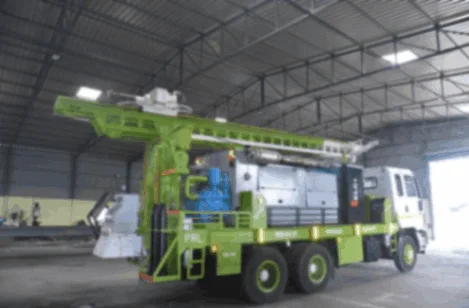
Drilling into the ground to access concealed water sources has ever been the most challenging activity throughout human history. All it requires is strength, patience, and the right approach to handle unstable ground and rock formations. Farmers, construction workers, and villages all depend upon stable below-ground water to ensure their daily requirements. While the job was still challenging, the process has been relatively easier and reliable with the evolution of sophisticated machinery. A water well rig is the essential machine that has completely transformed drilling by doing it faster, safer, and far better than in the old days.
- Why the Right Machine Matters: Water is one of the most valuable commodities, and it is not a simple matter to obtain. Manually drilling or with ancient devices is tedious and perilous, without guarantee of success. The right machine transforms drilling into a non-effort of time, effort, and capital. It lends certainty to the task by offering consistent power and precise control. Without equipment of this type, numerous projects would never make it beyond the water table.
- The Design of a Water Well Rig: Such a machine is constructed to undertake heavy work in adverse conditions. Its foundation is sturdy, made to remain stable on uneven terrain. The heavy engine supplies power to the drill bit that breaks through the earth’s layers. Each component of the rig is constructed to promote accuracy, hardness, and balance. Due to this construction, it can work for several hours without failure, an aspect that is greatly necessary for long drilling operations.
- Speed That Saves Time: Time is always critical in construction, agriculture, and rural development. Digging manually may take weeks to achieve the desired depth. A modern rig does the same work in a matter of hours or days based on ground conditions. Drilling faster does not imply low quality. Rather, speed goes hand in hand with precision, producing wells that are straight, deep, and sufficiently strong to endure.
- Reducing the Burden on Workers: Prior to machines, men would work hours on end with rudimentary tools, tiring themselves out for minimal gains. Most of the manual work is substituted by machine power in the case of a rig. The operator has the work of merely steering and keeping an eye on the process rather than conducting infinite physical labor. Not only has this raised efficiency, but the health and safety of workers have also been ensured.
- Safer Drilling Operations: Safety is at the top of drilling’s most crucial aspects. Drilling by hand made individuals vulnerable to collapsing dirt, accidents, and other hazards. A rig offers a safer solution. It features stable bases, regulated motion, and safeguarding capabilities. This significantly minimizes accidents and ensures the drilling runs smoothly without any surprise threats to workers or adjacent territory.
- Accuracy That Builds Trust: Reaching the water is only half of the job. A well must also be deep enough, properly aligned, and durable enough to survive for several years. Machines are engineered to accurately measure and achieve the desired depth. The outcome is a straight borehole that won’t collapse or shatter, providing dependable access to water for extended periods.
- Protecting the Environment: Earlier methods of drilling used to destroy the surrounding earth and waste a tremendous amount of fuel. New rigs are planned so that they conserve energy and have less impact on nature. They drill effectively without making deep impressions on the earth. By conserving resources and not attempting repeatedly, they conserve the environment as well, but still grant access to underground water.
- Saving Costs in the Long Run: It might seem costly to purchase or rent a water well rig at first. But its effectiveness soon translates into savings. Because it works faster, labor is reduced. Proper results also eliminate the expensive errors or redrilling. In the long run, these translate into savings that actually lower overall costs for big or small jobs.
- The Backbone of Rural Life: In rural areas and agricultural regions, water demand is perpetual. Wells are the source of life for irrigation, livestock, and consumption. Without efficient machines, these communities would not be able to sustain themselves. A rig allows wells to come online rapidly, enhancing access to clean water and fortifying rural economies. It is frequently the distinction between shortage and security.
- Role in Industrial Sectors: Apart from agriculture and residences, most industries also require robust water sources. Building projects utilize water to mix and construct, while energy and mining ventures rely on water to process. These businesses cannot stand any slowdown. A rig gives them the speed and reliability they need, advancing their operations without losing time.
- Importance of Training: While the machine is strong, it is also easy to use if dealt with after proper training. Operators learn how to operate their functions, monitor progress, and handle unforeseen situations. With sufficient skills, even intricate drilling is seamless and secure. Training also prevents damage to the machine and results in improved outcomes.
- Keeping the Machine in Good Condition for Years to Come: As with any good equipment, the rig operates best with proper maintenance. Routine checks on the engine, washing the parts, and changing drill bits when needed can help it last longer. Maintaining it ensures that the machine continues to be reliable for years, sustaining one project after another without these abrupt breakdowns.
- Looking Ahead with Innovation: The future of drilling is even more promising. Drilling rigs today are built using computer systems, smart sensors, and automation ability. These developments will enable even less human involvement and even more precision. Drilling will be more efficient, cost-effective, as well as eco-friendly with more innovation. The creation of this machine is still in progress with limitless possibilities.
Conclusion
The revolution introduced by drillers has simplified one of the most difficult tasks to do, making it faster and safer than ever. People, farmers, and industries alike now have reliable access to groundwater with less waiting. Each successful project is evidence of the significance of the machine and the commitment of the rig driller who runs it with care and competence. The advantages are time savings, less labor, lower expenses, and added safety.




